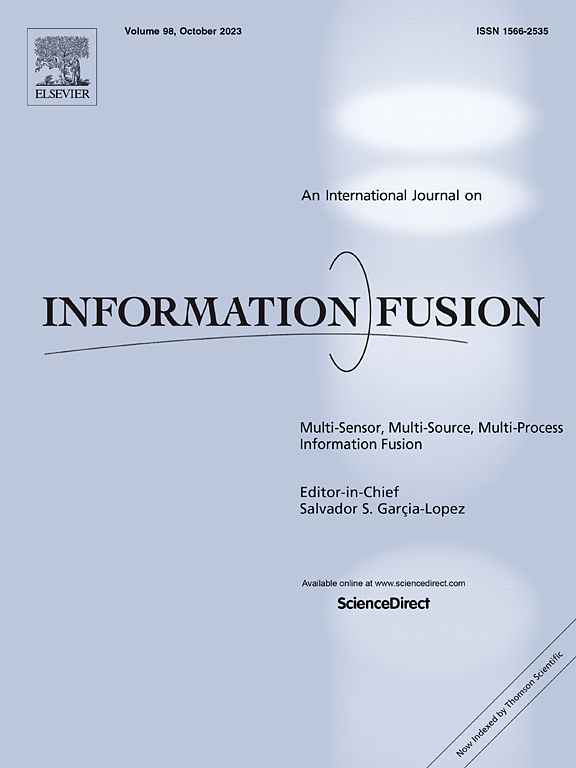基于核心数据选择的多类别融合对比学习鲁棒RGB图像龋齿分类
IF 14.7
1区 计算机科学
Q1 COMPUTER SCIENCE, ARTIFICIAL INTELLIGENCE
引用次数: 0
摘要
龋齿是影响人类,特别是青少年人群的最普遍疾病之一。RGB图像为龋齿检测提供了一种方便、经济的方法。然而,捕获的图像数据可能存在模糊性,再加上人工注释过程中引入的标签错误,会降低用于龋齿检测的学习模型的性能。为了解决这一问题,我们提出了基于核心数据选择的多类别融合对比学习(M3C)来提高龋病分类模型的预测性能。M3C不是对骨干网结构进行微调,而是通过识别与龋齿类别高度相关的核心数据,从一个新的角度提高模型的鲁棒性来标记错误。从模型架构表示、理论分析和互信息计算三个方面分析并验证了M3C在龋病检测方面具有较好的鲁棒性。具体来说,M3C基于Jensen-Shannon Divergence (JSD)对龋齿图像和龋齿类别中心之间的平均互信息进行量化,然后使用该互信息选择核心数据,以减轻标签错误对模型性能的影响。此外,我们设计了类别间对比学习,通过改进不同类别样本的特征表示来提高模型在区分龋齿类别方面的性能。在理论证明的基础上,我们利用预测损失和混淆对比损失对模型训练进行了联合优化。大量实验表明,在龋病RGB图像数据集上,M3C检测龋病明显优于对比数据选择方法。更令人兴奋的是,与使用整个数据集的最先进的龋齿检测方法相比,M3C仅使用50%的核心数据就实现了卓越的预测性能。我们的代码可在:https://github.com/papercodeforreview/Caries_Detection_Journal。本文章由计算机程序翻译,如有差异,请以英文原文为准。

Multi-Category Fusion Contrastive Learning with Core Data Selection for Robust RGB Image-based Dental Caries Classification
Dental caries represents one of the most prevalent diseases affecting humankind, particularly among adolescent populations. RGB images offer a convenient and cost-effective method for dental caries detection. However, the image data captured may suffer from blurriness, which, together with label errors introduced during manual annotations, can degrade the performance of the model learned for dental caries detection. To address this problem, we propose the Multi-Category Fusion Contrastive Learning with Core Data Selection (M3C) to improve the predictive performance of dental caries classification models. Instead of fine-tuning the backbone network structure, M3C focuses on improving the robustness of model to label errors from a novel perspective by identifying core data that is highly relevant to the dental caries category. We analyzed and validated that M3C has better robustness in dental caries detection from model architecture representation, theoretical analysis, and mutual information computation. Specifically, M3C quantifies the average mutual information between dental caries images and dental caries category centers based on Jensen-Shannon Divergence (JSD), which is then used for selecting the core data to mitigate the impact of label errors on model performance. Furthermore, we design inter-category contrastive learning to enhance the performance of the model in distinguishing the categories of dental caries by improving the feature representation for samples of different categories. With theoretical justification, we jointly optimized model training using prediction loss and confusion contrastive loss. Extensive experiments demonstrate that M3C significantly surpasses comparative data selection methods in dental caries detection on dental caries RGB image datasets. More excitingly, M3C achieves superior predictive performance using only 50% of the core data compared to state-of-the-art dental caries detection methods using the entire dataset. Our code is available at: https://github.com/papercodeforreview/Caries_Detection_Journal.
求助全文
通过发布文献求助,成功后即可免费获取论文全文。
去求助
来源期刊

Information Fusion
工程技术-计算机:理论方法
CiteScore
33.20
自引率
4.30%
发文量
161
审稿时长
7.9 months
期刊介绍:
Information Fusion serves as a central platform for showcasing advancements in multi-sensor, multi-source, multi-process information fusion, fostering collaboration among diverse disciplines driving its progress. It is the leading outlet for sharing research and development in this field, focusing on architectures, algorithms, and applications. Papers dealing with fundamental theoretical analyses as well as those demonstrating their application to real-world problems will be welcome.
 求助内容:
求助内容: 应助结果提醒方式:
应助结果提醒方式:


